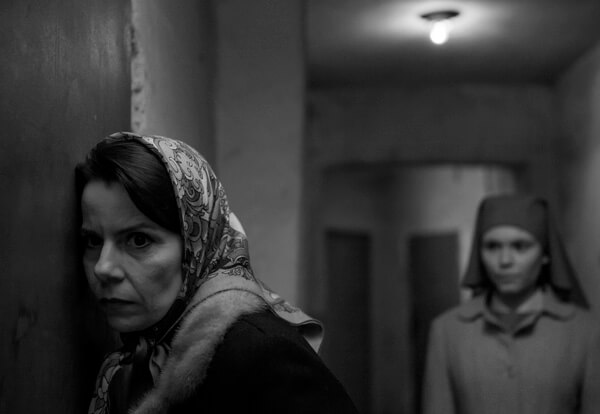Agata Kulesza and Agata Trzebuchowska in Pawel Pawlikowski’s “Ida.” | MUSIC BOX FILMS
Polish director Pawel Pawlikowski’s “Ida” is a strangely lopsided film. The story of its title character (Agata Trzebuchowska), a young woman raised in a convent who suddenly discovers she’s Jewish, it’s a road movie depicting her relationship with her aunt (Agata Kulesza) for most of its running time. To a large extent, its cinematography is more compelling than its characters, who are more interesting apart than together.
The narrative generates suspense from the question of whether Ida will embrace her Jewish identity. Without ever referring to LGBT issues, it portrays Poland in the 1960s as a nation of closets, mostly having to do with anti-Semitism and the crimes of Stalinism. I don’t want to give away the ending, but one can read it either as a positive refusal to participate in such crimes or a decision not to engage constructively with the modern world.
Eighteen-year-old Anna is on the verge of taking her vows. Having been orphaned during World War II, she’s never known a home other than the convent, and becoming a nun is her obvious destiny. However, the Mother Superior tells her to visit Aunt Wanda, her sole living relative. Wanda is a judge and a well-connected Communist Party insider — she can get out of a DUI arrest and have a cop apologize to her about it the next morning. Wanda tells Anna that her real name is Ida and her parents were Jews killed during the Occupation. The two women go on a road trip into the countryside, looking for her parents’ home. This journey unearths secrets that early ‘60s Poles would rather forget about — and it challenges Ida’s blind faith and Wanda’s blithe cynicism.
Pawel Pawlikowski explores the ugly truths facing Poland in the 1960s
Two cinematographers worked on “Ida.” I’m not sure if they collaborated or worked separately, but the film’s look is seamless. Shot in black-and-white, it uses every tone of that particular palette. Several scenes that consist of rich, inky slabs of darkness broken up by a few shards of light are particularly memorable. The film also gets maximum mileage from black-and-white digital video’s tendency to turn all on-screen light sources into unnaturally glowing orbs.
Pawlikowski’s depiction of 1962 Poland suggests the rough-hewn New York and Cleveland settings of Jim Jarmusch’s “Stranger Than Paradise.” There’s something strangely appealing about the rawness of Polish highways, even if the setting sometimes crosses over into sheer ugliness.
Claude Lanzmann unearthed the depths of Polish anti-Semitism, historical and contemporary, back in 1985 with his mammoth documentary “Shoah,” and while the look of “Ida” is seductive, its first two-thirds feel overly familiar. Pawlikowski’s conception of his characters is overly schematic. Wanda refers to herself as “Red Wanda.” While she shows no overt remorse for sending people to their execution, her alcoholism is clearly meant to stem from that.
On the other hand, Trzebuchowska’s performance errs on the side of obliqueness, allowing her character to be defined by her faith and little else. Ida says she never feels tempted by “carnal love.” From most 18-year-olds, this would be an obvious lie, but coming from Ida, one tends to believe her.
The characters in “Ida” are contemporaries of the French New Wave and Roman Polanski’s debut “Knife in the Water,” but while the cinematography of Pawlikowski’s film at points evokes the early films of Jean-Luc Godard, Claude Chabrol, and Francois Truffaut, Wanda and Ida are no cinephiles. The modern world makes itself felt in their lives through another art form: jazz. A woozy cover of John Coltrane’s “Naima” is perfectly chosen as Ida heads down to a deserted dance floor for a late night rendezvous with a musician. ‘60s Poland had a rich tradition of jazz and experimental music, which is evident from soundtracks of films made in the country at the time. Pawlikowski seems to be paying homage to this, something Poles can be proud of, unlike the historical wreckage Ida and Wanda uncover.
As a wave of “faith-based” films hits American theaters, “Ida” strikes me as an intriguing parallel European effort at examining organized religion. If it ends by reaffirming Christian values (at least in one interpretation), it also suggests the merits of seriously testing them. Deliberately old-fashioned — not only black-and-white but also using the boxy 1.33 aspect ratio — it transcends retro nostalgia for a real examination of the past.
IDA | Directed by Pawel Pawlikowski | In Polish with English subtitles | Music Box Films | Opens May 2 | Film Forum, 209 W. Houston St. | filmforum.com | Lincoln Plaza Cinemas, 1886 Broadway at 62nd St. | lincolnplazacinema.com



































